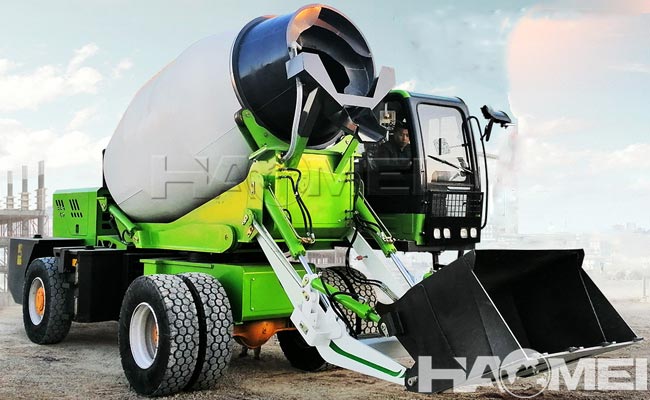What is Self Propelled Concrete Mixer?
A self propelled concrete mixer is a concrete production equipment that integrates the functions of automatic material loading, mixing and transportation. Compared with traditional concrete mixers, it does not need to rely on external loading machinery (such as loaders and conveyor belts), and can automatically complete the grabbing and transportation of raw materials such as sand, stone, and cement through its own configured loading system (such as hoppers and conveyor belts). At the same time, it has the ability to move by itself (usually using wheeled or crawler chassis), which is suitable for use in small and medium-sized construction projects, rural construction, road maintenance and other scenarios.

The working process of the self propelled concrete mixer can be divided into the following key links. Its principle relies on the coordinated operation of the equipment's automation system, loading mechanism and mixing device:
1. Raw material loading stage
- Automatic grabbing of raw materials: The front end of the equipment is equipped with a liftable hopper (or bucket). The operator controls the hopper through the control system to directly grab sand, stone and other aggregates from the pile. Some models are also equipped with a cement silo interface, which can be automatically connected to the cement delivery pipeline.
- Metering and conveying: After the hopper grabs the raw materials, the materials are sent to the metering system (such as an electronic scale) through a conveyor belt or a lifting mechanism, and weighed according to the preset mix ratio to ensure the accuracy of the raw material ratio.
2. Mixing and mixing stage
- Material is put into the mixing tank: The aggregates, cement and other raw materials after measurement enter the rotating mixing tank (usually an inclined or horizontal tank body) through the conveying channel, and the system automatically adds a certain amount of water (or additives).
- Mixing operation: The mixing tank is driven to rotate by a motor, and the internal mixing blades mix the materials evenly to form concrete that meets the construction requirements. The mixing time can be adjusted through the control system to ensure that the slump and workability of the concrete meet the standards.
3. Unloading and moving stage
- Unloading method: After the mixing is completed, the mixing tank can be tilted through the hydraulic system to release the concrete from the discharge port at the bottom of the tank body and directly poured to the designated location (such as formwork, transport vehicle).
- Self-movement: The self loading concrete mixer chassis is equipped with an engine and a walking mechanism (wheeled or crawler), which can be moved freely on the construction site without the need for additional transportation tools and adapt to complex terrain.
4. Control system and automation
The equipment is usually equipped with a PLC control system or a touch screen operation interface. The operator can set parameters such as raw material ratio and mixing time. Some high-end models support GPS positioning or remote monitoring to improve construction efficiency and management convenience.
Core advantages of self propelled concrete mixer:
- Strong mobility
No need to disassemble and transport, it can be directly driven to different construction sites, reducing the time spent on equipment transfer (traditional fixed types need to be disassembled and transported, and installation and commissioning takes 1-2 days).
- Save costs and time
On-site mixing avoids the loss of concrete during transportation (such as slump loss and transportation vehicle costs), which is especially suitable for remote or inconvenient construction sites.
- Adapt to complex sites
Crawler models can operate in harsh terrains such as mud and steep slopes, and tire models are suitable for highway and urban road construction without additional site leveling.
- High functional integration
Integrates batching, mixing, and transportation. Some models support automatic water supply and electronic metering, which reduces the difficulty of manual operation and improves the stability of concrete quality.
- High cost-effective investment
The purchase cost of small and medium-sized models is lower than that of fixed concrete mixing plants, and they are suitable for recycling in multiple projects, with lower long-term use costs.
Applicable scenarios of self propelled concrete mixer:
- Construction sites and real estate projects
Applicable to the concrete pouring of multi-story residential and commercial buildings, especially in the construction of high-rise buildings, which can be moved to different buildings as the construction progresses to reduce the pumping distance.
- Road and bridge construction
Used for mixing the water-stabilizing layer of the highway base and pouring concrete for bridge piers, it can be moved along the construction line to avoid the segregation problem caused by long-distance transportation of concrete.
- Rural and township construction
In scenes such as rural self-built houses, rural roads, and farmland water conservancy projects (such as irrigation canals), self-propelled mixers can be operated directly on site due to the scattered sites and inconvenient transportation.
- Emergency projects and disaster relief
Infrastructure repair after disasters such as earthquakes and floods, the equipment can quickly arrive at the site and mix concrete on site for road and dam repair.
- Small municipal engineering
Urban pipeline backfilling, sidewalk renovation, park landscape construction, etc. The equipment is small in size and easy to move, suitable for working in narrow spaces.
- Mining and Tunnel Engineering
For mine tunnel support and initial tunnel lining concrete pouring, crawler models can operate stably in wet and narrow underground environments.
With the composite function of "mobile + mixing", self propelled concrete mixers solve the limitations of traditional fixed equipment in flexibility and site adaptability. They are especially suitable for engineering scenes with "many points, wide areas and dispersion", and are the preferred equipment for small and medium-sized construction projects and operations in complex terrain.
Inquiry
| (Please write down the product model or any requirement) | |
| E-mail: | |
| Message: | |
Contact Information
E-mail:chris@concretebatchplant24.com
Tel: +86-371-65621392
Fax:+86-371-86616825
Add : No.14 Waihuan Road,New strict,Zhengzhou,China


